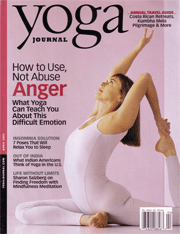Articles
Advanced Pigeon Pose
Eka Pada Rajakapotasana IV (One-Legged King Pigeon Pose IV) is a beautiful advanced-level asana. When you see someone doing this pose, you may think you will never be flexible enough to do it yourself. But this version of Pigeon favors almost no one: It demands deep flexibility throughout the entire body and equal amounts of strength to keep the joints stable—and most of us can only develop this potent combination through practice. When you observe a skillful Eka Pada Rajakapotasana IV, you're witnessing the result of hours spent refining many different poses to prepare for this one.
Revolved Triangle Pose
Every time you walk across a room, reach into the back seat of your car, or pass a dish at dinner, you rotate your spine. You probably take such movements for granted most of the time, but imagine being unable to do them. If you've ever had back spasms or a crick in your neck, you know how debilitating it is when you can't turn sideways. Without access to the full range of motion in your spine, your life becomes very limited, but when your spine is strong and supple, you radiate well-being.
Feel the Wheel in Pigeon Pose
Build up to Kapotasana by creating a flow of circular energy in your spine.
Tittibhasana (Firefly Pose)
I love arm balances. They have an invigorating electricity despite, or perhaps because of, the fact that they are such demanding asanas. Arm balances are also marvelous equalizers. They come easily for almost no one.
Parivrtta Trikonasana
(Revolved Triangle Pose)
One of my first yoga teachers, a wonderful Englishwoman named Penny Nield-Smith, was a real stickler for standing poses; we practiced them endlessly. I would look at yoga books and see pictures of headstands, backbends, arm balances, exotic stuff, but when I went to class it was, you guessed it, more standing poses.
Dwi Pada Viparita Dandasana
I fall into my yoga practice with relish akin to getting into bed at the end of a long day. Many people start their practice with a series of asanas such as Surya Namaskar (Sun Salutation) to warm the body up, but I usually start by lying over a bolster that I've placed under my back.
Paschimottonasana
As yogis, we have learned that a disciplined practice yields positive results. We've also learned that we can usually produce specific results by doing certain poses or practicing a particular method. Some asanas will help an aching back, others relieve depression; one method builds strength, another is meditative; and so on.
Downward-Facing Dog to Upward Bow
Earlier this year while watching Jazz, filmmaker Ken Burns's documentary series, I was struck by a comment from Chicago jazz great Eddie Condon. A leader in the desegregation of jazz, Condon observed that when white musicians first came on the scene they were eager to play jazz but "stiff with education." I was reminded that as we in the West embrace the ancient tradition of yoga, we need to leave room for the earthy elements that keep a yoga practice as playful as it is serious.
Salamba Sarvangasana
I have great sympathy for students who struggle with Salamba Sarvangasana (Shoulderstand). Because of an old neck injury, Salamba Sarvangasana used to be quite difficult for me. My neck and upper back ached in the pose and throbbed for several minutes after I came out of it. About twice a year I would strain muscles in my upper back while practicing Shoulderstand.
Crick Fixes
Master these gentle moves to create lasting ease. Even if you have a history of injuries or have suffered from chronic tension for years, the approach I've developed can help you learn to soften your neck and shoulder muscles and restore ease and freedom. This article was published in the December 2005 issue of Yoga Journal.
Asthma Fixes
Following an emergency visit to the intensive care unit, yoga teacher Barbara Benagh pledged to find a way to better manage her asthma. After extensive research, she discovered the key to overcoming asthma is retraining the breath. Since writing this article she has become acquainted with The Buteyko Method, a revolutionary technique for reducing asthma symptoms, that has refined her original work.
Barbara Benagh has been a frequent contributor to Yoga Journal and was a regular presenter for years at Yoga Journal Conferences. She wrote the Asana column in 2001 and appeared on the April 2002 cover. These articles were all first published by Yoga Journal magazine.
